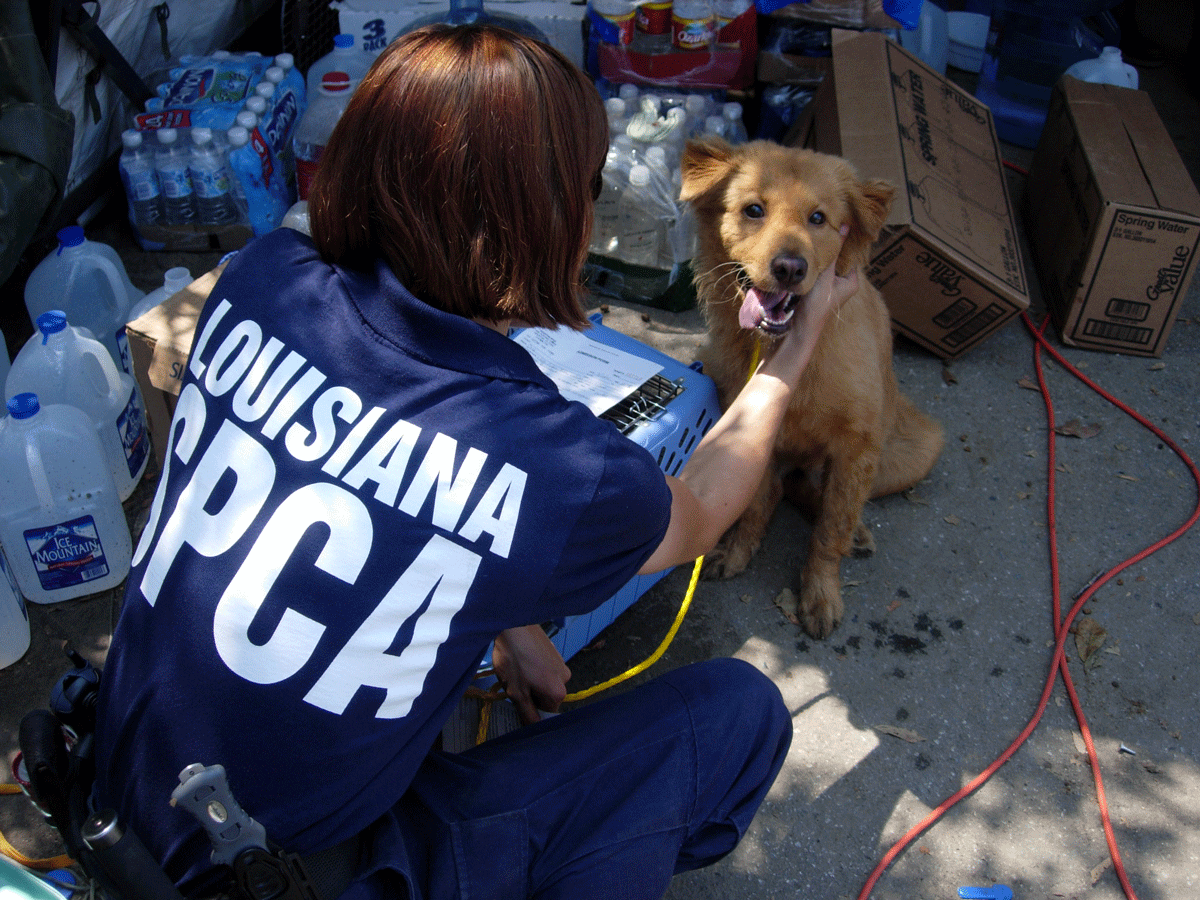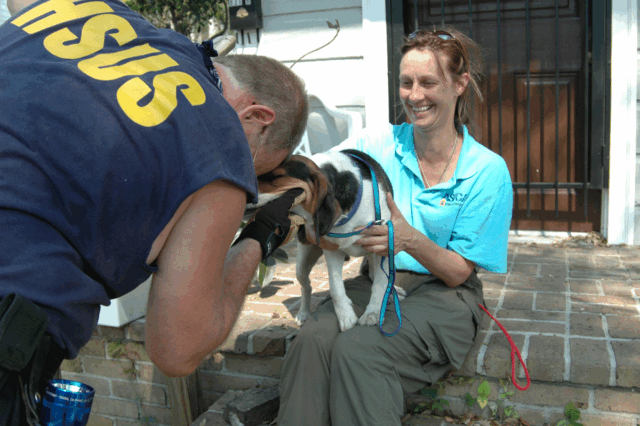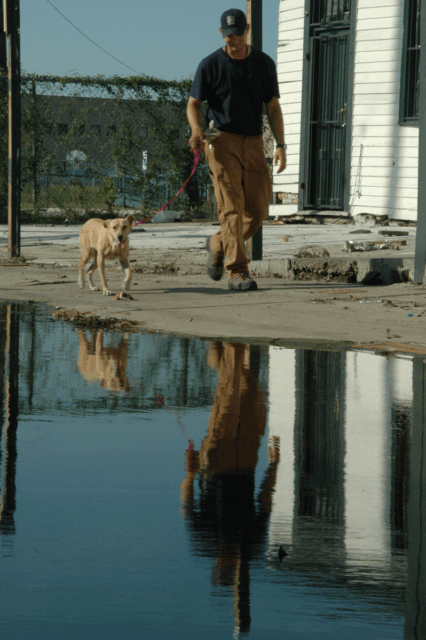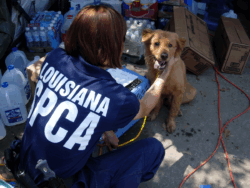Summer 2025
For the Love of Cats and Dogs
Remembering the efforts to rescue and reunite pets with their owners post-Katrina, twenty years later
Published: May 30, 2025
Last Updated: June 3, 2025

Photo by Chad Sisneros, courtesy of Humane World for Animals
An LSPCA employee pets a dog rescued post-Katrina.
When Hurricane Katrina made landfall in Louisiana on August 29, 2005, history professor Rosanne Adderley was visiting family in the Bahamas. Her cats—Marcus, Chloe, and Creole—were at her house in New Orleans. The animals were in good hands, or at least they had been, looked after by a graduate student who’d planned to evacuate with them. But when contraflow reversed the direction of inbound traffic, the student was unable to get to them. Like the majority of the city’s pets, the cats were stuck, left to ride out the massive storm alone. As gambles go, Rosanne figured it was high stakes, but low risk; the cats had enough food and water for a few days. By the time they ran out, Rosanne planned to be back.
More than one million people, 92 percent of the population of the greater New Orleans area, evacuated for Hurricane Katrina, stranding as many as three hundred thousand pets. For most, separation was a matter of necessity. A day before the hurricane made landfall, Mayor Ray Nagin ordered the city’s first ever mandatory evacuation. Leaving was no longer a choice, but most evacuation buses didn’t allow pets. Bus riders had to either forfeit their animal or stay behind and forfeit their safety. Some people tied their cats or dogs to bridges, hoping the high ground would protect them from flooding. Others refused to be separated and stayed put. Folks with cars had more options, but even then, managing pets wasn’t straightforward. Not everyone had carriers, and those that did didn’t always have space for them in their cars. Some pets refused to be caught. Others didn’t travel well. New Orleanians were forced to make difficult calculations on a short timeline: food and water multiplied by anticipated days gone factored by temperament and whatever the churning maelstrom might do to the city.
Rosanne watched New Orleans flood on a television in her father’s house. “My poor damn cats,” Rosanne remembers thinking. Marcus and Chloe were young and healthy, but Creole was thirteen at the time and ailing. The food and water would be gone soon, and, to make matters worse, Rosanne had instructed her cat sitter to keep the bathroom door closed. “I’m a little bit type A,” she told me. “I don’t let my kids drink out of the toilet.”
“I had an ethical duty,” Rosanne recalled. “I was like, hang on cats. I’m coming!”

A Humane Society of the United States (now called Humane World For Animals) employee rescues a dog from a flooded home post-Katrina. Photo by Chad Sisneros, courtesy of Humane World for Animals
But going home wasn’t an option. The New Orleans airport was closed. So was the city. Delta was willing to change her return ticket to New York. Camped out in her sister’s New York City apartment, she called friends, crowd-sourcing solutions until she got the number of a journalist who might be willing to check on the cats. “If you’re trying to get into my house, my side door is the weakest door in the house,” she told him on the phone. “An average-size man could put a good shoulder on that.”
After losing their Japonica Street shelter to flooding, around a dozen people from the Louisiana SPCA set up shop at the Lamar-Dixon Expo Center in Gonzales. The 247-acre grounds were designed to host colossal events—rodeos, 4-H fairs, gun shows, cattle auctions—and could house thousands of lost pets. Already, inquiries from desperately worried pet owners were piling up. Two days after Katrina hit, the staff divided into three teams and drove an hour into New Orleans, a humble start for what would eventually become the largest animal rescue operation in US history.
More than one million people [. . .] evacuated for Hurricane Katrina, stranding as many as three hundred thousand pets.
Rescue teams sledgehammered doors, crowbarred plywood from windows, pulled out air conditioners, and broke windows, getting into the houses however they could. The work was slow and often gross. The houses were moldy and waterlogged. “You smelled death,” remembered Jane Garrison, an independent pet rescue volunteer who arrived a week after the city flooded. “And you didn’t know, was it the pet or was it [rotten meat] in the refrigerator?”
Dogs were stuck in crates, chained up in yards, and stranded atop bookshelves and roofs. Cats cowered in cabinets, box springs, and crawl spaces. “I could knock on the side of a building and hear barking coming from so many different areas,” remembered Garrison. “It was such a painful thought—animals [that] made it through the hurricane are going to die of starvation and dehydration.” Some pets were easy to find. Others were too frightened to come out, so volunteers left food and water and spray-painted messages on the sides of houses alerting future rescuers to try again.
Officially, the Louisiana SPCA reported that they had the situation under control, but by their own account, they were short-staffed and overwhelmed. The organization specialized in animal control work. Locating thousands of pets amid devastating flood wreckage and reuniting them with owners was something else entirely. Garrison, who had rescued pets after floods in California and tornadoes in Arkansas, recognized the urgent need for more volunteers. Internet hadn’t yet been restored in Gonzales so, two weeks after New Orleans flooded, she called her husband back home and dictated an email. “We are running on empty here in South Louisiana,” read the plea he blasted to animal shelters across the country. “[We] are desperate.”

A man carrying an assault rifle and ax walks in front of a house spraypainted to indicate a dog trapped inside post-Katrina. Photo by Kathy Milani, courtesy of Humane World for Animals
“It was the Wild West,” recalled Sheryl Blancato, a Humane Society of the United States (since renamed Humane World for Animals) volunteer who flew in from Massachusetts a month after Hurricane Katrina made landfall. “I don’t think people realize the magnitude of it . . . Animal rescue had never happened at this scale before.” By this point, Garrison had taken charge of rescue operations, dividing the city into sections and coordinating volunteers, who were arriving from across the country. At four thirty each morning, she handed out maps and addresses and the teams set out.
Aside from the occasional insurance adjuster or homeland security guards, the city was abandoned. Streetlights didn’t signal. Dried mud crunched underfoot. Debris punctured car tires. “It was so hot,” remembered Alex Chernavsky, an employee of the Humane Society of Greater Rochester, who’d driven from New York with colleagues after reading the email Garrison had dictated to her husband. “Just oppressively hot.”
Space at the Expo Center was limited. Volunteers prioritized finding animals in houses over catching strays. When possible, they taped owners’ mail to the pet carriers, hoping addresses and owner names might speed up reunions and free up crates for the next round of rescues. Out on the street, dogs were going hungry and forming packs. There no garbage to rummage through, nothing at all to eat. On Garrison’s instructions, volunteers began filling aluminum lasagna pans with water and leaving open bags of kibble on street corners, hoping to at least keep the animals alive.
Back in Gonzales, HSUS joined forces with the Louisiana SPCA to manage volunteers who were arriving daily from around the world. They organized teams to take care of food and water, walk dogs, change litter boxes, and hose down carriers. HSUS secured leases for five of the Expo Center’s giant open-air barns—allocating three for dogs, one for horses, and another for cats alongside a make-do veterinary hospital. The horses were kept in stables, and the rest of the animals were arranged in long rows of stacked crates. Each evening, volunteers delivered around three hundred new rescue animals from New Orleans, their cars forming a line that stretched a mile or more down the road.
Volunteers began filling aluminum lasagna pans with water and leaving open bags of kibble on street corners, hoping to at least keep the animals alive.
Most rescues were dogs or cats but there were also rabbits, hamsters, turtles, birds, and even a pot-bellied pig. Each animal needed to be assessed and assigned a color—green, yellow, red, or black—according to its health. Veterinarians came from across the country, volunteering their services for a seemingly endless triage. All the animals received emergency evaluations, vaccinations, micro-chips, and baths. “We took a picture of every animal that came in [to post online],” Chernavsky told me. “In theory, people could try to find their missing animals [on websites like Petfinder.com], but I got the sense that that didn’t happen very often.”
Paige Breaux was eight months pregnant when she evacuated to her sister’s house in Atlanta. Harry, her poodle, was still a puppy. Reggie was a five-year-old Springer Spaniel with a goofy disposition, a missing toe, and an underbite. She had a gray tabby cat who stayed indoors, and an outdoor cat who pretended he hated her. The four animals had ridden out the storm in Mid-City with her father. When he had to leave the city in the aftermath—with his six pets of his own—he dropped off Paige’s at a local pet store called Jefferson Feed.
By the time she was ready to retrieve her pets, she’d given birth and couldn’t travel to look for them. “The whole thing was incredibly upsetting,” Paige told me. According to a listing Paige found on Petfinder, the dogs and cats had been relocated to the Expo Center. But when her father went to fetch them two weeks after Katrina, they were no longer there.

HSUS and ASPCA employees cuddling a recently rescued dog post-Katrina. Photo by Kathy Milani, courtesy of Humane World for Animals
Keeping track of thousands of lost pets would be a Herculean task in the best of circumstances. In the aftermath of a hurricane and catastrophic flood, it was nigh impossible, especially without a system already in place. Paperwork at the Expo Center was haphazard. Volunteers rotated through, lasting anywhere from a few days to two months. They were exhausted, working twenty-hour shifts and sleeping in their cars. Some had injuries—cat scratches, dog bites, cuts from broken window glass. Others suffered from heat stroke. When trucks arrived to collect animals from the Expo Center and take them to out-of-state shelters, documentation didn’t always follow. Planning was chaotic. Space was at a premium. New rescues were constantly coming in. Of the estimated fifteen thousand pets who passed through the Lamar-Dixon Expo Center, only twenty percent reunited with their owners.
Stuck in Atlanta, Paige held her new baby and scrolled through pet listings looking for Harry and Reggie and the cats. A few weeks after the storm hit, she got a call from Gonzales. Two volunteers at the Expo Center had taken Harry home with them to Prairieville, Louisiana, and were fostering him alongside their own poodles. A few days later, some other volunteers located Reggie at a shelter in Lake Charles, Louisiana. By then, Hurricane Rita had formed in the Gulf of Mexico, and the shelter staff in Lake Charles were preparing to evacuate their entire animal inventory by plane to San Diego.
Paige contacted Harry’s foster owners in Prairieville; they offered to evacuate Reggie from Lake Charles and look after both dogs until Paige could take them back. The tabby cat was in New York by way of Florida. The street cat was in Texas. “We got all four of them back,” Paige told me on the phone, her voice still filled with disbelief, nearly two decades after their reunion. “It was amazing.”
Back in New York, Rosanne had prepared herself for the worst. “People have died,” she told herself. “People are suffering.” If her cats died at home, she planned to buy bags of lime and cover her floors. Two weeks after the storm hit, the journalist who’d offered to check on her cats got back to her. His news wasn’t bad: HSUS was in the city, and the pets on her block of Chippewa street had been rescued. Rosanne took a plane from New York City to Baton Rouge, the city with the closest airport to Gonzalez. She hadn’t found her cats listed anywhere online and wanted to look for them in person.
By then, a reception area was set up at the Expo Center to help folks seeking their pets. “Some of these people had completely lost their home,” recalled Garrison. “The only thing they wanted was their dog [or] their cat.” When reunions happened, it perked everyone up. “Those were the moments that we looked for,” Blancato said, remembering an owner who fell on her knees and wept when she caught sight of her dog.
Rosanne was one of the lucky ones. Volunteer receptionists led her to the cat barn, where she searched crates until she found Marcus and Chloe huddled in a carrier. “I could not believe it,” she said. “I was the happiest person alive.”

An HSUS employee walking a recently rescued dog near the receeding floodwaters post-Katrina. Photo by Kathy Milani, courtesy of Humane World for Animals
But her oldest cat, Creole, wasn’t there. Rosanne looked everywhere, even hitching a ride with a volunteer to check out a makeshift shelter in New Orleans’s Central City. Days later, she located Creole at the LSU vet school. The elderly cat had had a cardiac event and been transported there from the Expo Center for emergency surgery. When Rosanne finally saw him, his fur was shaved and his body was covered in tape. He was too weak to leave the veterinarians’ care.
By October, the coalition that had formed between the Louisiana SPCA, HSUS, and countless unaffiliated volunteers was breaking down as institutional strategies shifted. On October 1, HSUS downgraded their operation from a national rescue to a local recovery and ended their lease at the Lamar-Dixon Expo Center. The Louisiana SPCA began plans to open a new shelter in the Algiers neighborhood of New Orleans. And then, on October 25, less than two months after Hurricane Katrina made landfall, Governor Kathleen Blanco’s emergency licensing program, which allowed out-of-state veterinarians to practice in Louisiana, ended. The Lamar-Dixon Expo Center’s rescue operation was officially over.
Jane Garrison continued her work as long as she could, driving into the city at dawn, trapping animals by day, and organizing data by night. By her own count, she rescued over two thousand pets “with her own hands.” When HSUS stopped sending rescue teams to New Orleans, Garrison kept going, certain there were thousands of pets who still needed to be rescued. “[The state] said that [the volunteers I organized] were radical and rogue. But there were animals suffering. If [police] wanted to arrest me, I said, arrest me.”
Frustrated and suffering from a feral cat bite, Garrison returned home at the end of October, where she continued coordinating rescues for six more months. The volunteers she befriended eventually opened a permanent no-kill shelter, called Animal Rescue New Orleans, which operates to this day.
Over time, the public response to Hurricane Katrina shifted from horror to blame. The policies in place forcing people to leave animals behind were unethical; pets were family, and some New Orleanians died because they wouldn’t be separated from their animals. In 2006, Governor Blanco signed the Louisiana Pet Evacuation Bill, requiring that pets be included in disaster planning. At the federal level, the Pets Evacuation and Transportation Standards Act of 2006 provided similar protection.
But Garrison said large-scale pet rescues continue to suffer from mismanagement. In the wake of disasters, poor coordination, unprepared agencies, and onerous restrictions cost animals their lives. “Mistakes made after Hurricane Katrina are still being made today, twenty years later,” she told me over the phone from Los Angeles, where she was assisting with the pet rescues in the wake of the January fires. “We have these trail cameras where houses have burned down. We have video of [cats] outside their houses, and [officials] refuse to allow rescuers in.”
Weeks after he was released from the LSU vet school, Creole passed away. His official cause of death was idiopathic heart failure, but Rosanne blames Katrina. “You damn well know at least a hundred people that died the way my cat died,” she said, referencing the spike in elderly fatalities in the storm’s immediate aftermath. But she’s not bitter. Not even a bit. Ask Rosanne and she’ll tell you that her cats’ rescue was a miracle, proof that in the worst of times, goodness rises.
“What sort of a world do we live in where this is even possible?” she wondered aloud to me over the phone. In the background, I could hear the sound of her newest cat purring. “People who had no stake in this had figured out the thing they could solve…. [They] got it right.”
Anya Groner is a journalist, fiction writer, and essayist with work in Guernica, The New York Times, The Oxford American, The Guardian, Orion Magazine and The Atlantic.
